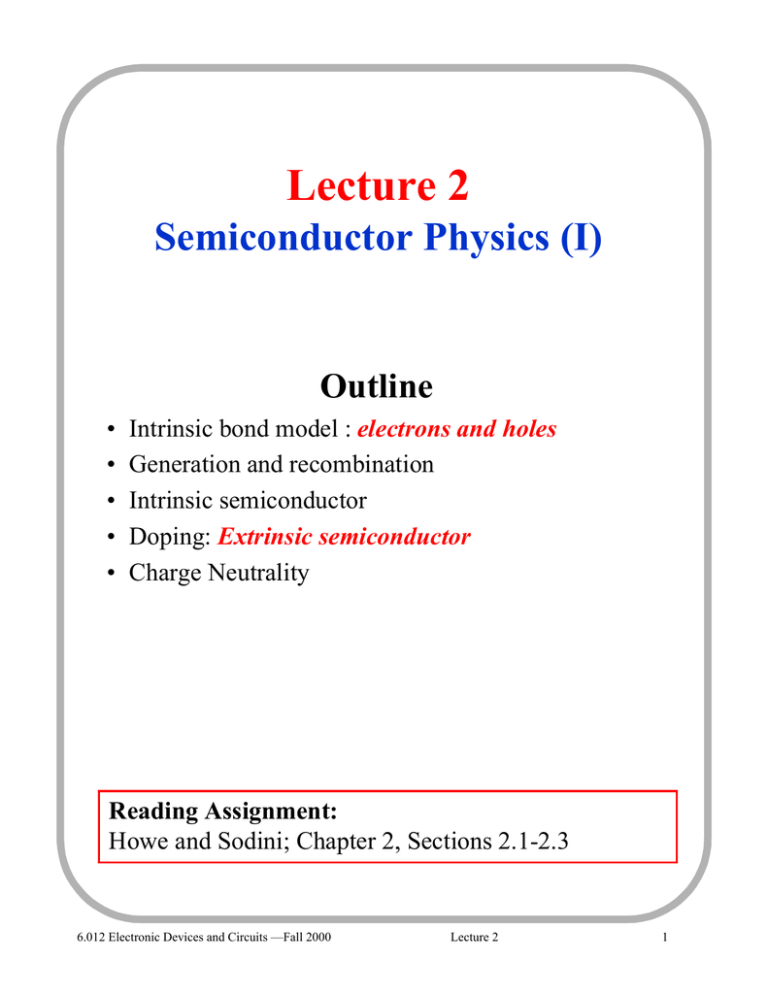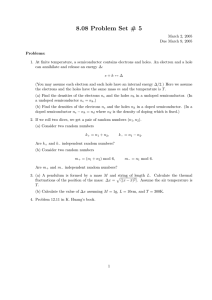N - MIT
advertisement

Lecture 2 Semiconductor Physics (I) Outline • • • • • Intrinsic bond model : electrons and holes Generation and recombination Intrinsic semiconductor Doping: Extrinsic semiconductor Charge Neutrality Reading Assignment: Howe and Sodini; Chapter 2, Sections 2.1-2.3 6.012 Electronic Devices and Circuits —Fall 2000 Lecture 2 1 Why are IC’s made out of Silicon? SILICON IS A SEMICONDUCTOR— a very special class of materials • Two types of “carriers” (mobile charged particles): – electrons and holes • Carrier concentrations can be controlled over many orders of magnitude by addition “dopants” – selected foreign atoms • Carrier concentrations can be controlled electrostatically • …. 6.012 Electronic Devices and Circuits —Fall 2000 Lecture 2 2 1. Silicon bond model: electrons and holes Si is in Column IV of the periodic table: • Electronic structure of silicon atom: – 10 core electrons (tightly bound) – 4 valence electrons (loosely bound, responsible for most of the chemical properties • Other semiconductors: – Ge, C (diamond form) – GaAs, InP, InGaAs, InGaAsP, GaN, ZnSe, CdTe (on the average, 4 valence electrons per atom) 6.012 Electronic Devices and Circuits —Fall 2000 Lecture 2 3 Silicon crystal structure • Diamond lattice: atoms tetrahedrally bonded by sharing valence electrons – covalent bonding • Each atom shares 8 electrons – low energy situation • Si atomic density : 5 x 1022 cm-3 6.012 Electronic Devices and Circuits —Fall 2000 Lecture 2 4 Simple “flattened” model of Si crystal At 0K: • All bonds are satisfied – ⇒ all valence electrons engaged in bonding • No “free” electrons 6.012 Electronic Devices and Circuits —Fall 2000 Lecture 2 5 At finite temperature • • • Finite thermal energy Some bonds are broken “free” electrons – Mobile negative charge, -1.6 x 10-19 C • “free” holes – Mobile positive charge, +1.6 x 10-19 C Caution: picture is misleading! Electrons and holes in semiconductors are “fuzzier”: they span many atomic sites 6.012 Electronic Devices and Circuits —Fall 2000 Lecture 2 6 A few definitions: • In 6.012, “electron’ means free electron • Not concerned with bonding electrons or core electrons • Define: – n ≡ (free) electron concentration [cm-3] – p ≡ hole concentration [cm-3] 6.012 Electronic Devices and Circuits —Fall 2000 Lecture 2 7 2. Generation and Recombination GENERATION = break-up of covalent bond to form electron and hole • Requires energy from thermal or optical sources (or other external sources) • Generation rate: G = G(th) + Gopt + ....[cm −3 • s−1 ] • In general, atomic density >> n, p ⇒ G ≠ f(n,p) – supply of breakable bonds virtually inexhaustible RECOMBINATION = formation of covalent bond by bringing together electron and hole • • • Releases energy in thermal or optical form Recombination rate: R = [cm −3 • s−1 ] 1 recombination event requires 1 electron + 1 hole ⇒ R ∝ n• p Generation and recombination most likely at surfaces where periodic crystalline structure is broken 6.012 Electronic Devices and Circuits —Fall 2000 Lecture 2 8 3. Intrinsic semiconductor QUESTION: In a perfectly pure semiconductor in thermal equilibrium at finite temperature, how many electrons and holes are there? THERMAL EQUILIBRIUM = Steady state + absence of external energy sources Generation rate in thermal equilibrium: G o = f(T) Recombination rate in thermal equilibrium: Ro ∝ no • po In thermal equilibrium: G o = Ro ⇒ no po = K(T) = ni (T) 2 ni ≡ intrinsic carrier concentration [cm −3 ] In Si at 300 K (“room temperature”): ni ≈ 1x1010 cm-3 In a sufficiently pure Si wafer at 300K (“intrinsic” semiconductor): no = po = n i ≈ 1× 1010 cm −3 ni is a very strong function of temperature T ↑⇒ ni ↑ 6.012 Electronic Devices and Circuits —Fall 2000 Lecture 2 9 4. Doping Doping = engineered introduction of foreign atoms to modify semiconductor electrical properties A. DONORS: • Introduce electrons into the semiconductor (but not holes) • For Si, group V elements with 5 valence electrons (As, P, Sb) 6.012 Electronic Devices and Circuits —Fall 2000 Lecture 2 10 Doping: Donors Contd... • • • 4 electrons participate in bonding 5th electron easy to release ⇒ – at room temperature, each donor releases 1 electron that is available for conduction Donor site become positively charged (fixed charge) Define: • Nd ≡ donor concentration [cm-3] If Nd << ni, doping is irrelevant – Intrinsic semiconductor ⇒ no = po = ni 6.012 Electronic Devices and Circuits —Fall 2000 Lecture 2 11 Doping: Donors Contd... • If Nd >> ni, doping controls carrier conc.. – Extrinsic semiconductor ⇒ no = N d n2i po = Nd Note: no >> po : n-type semiconductor Example: Nd = 1017 cm-3 → no = 1017 cm-3 , po = 103 cm-3 In general: • • Nd ≈ 1015 - 1020 cm-3 Electrons = majority carriers Holes = minority carriers 6.012 Electronic Devices and Circuits —Fall 2000 Lecture 2 12 Doping : Acceptors B. ACCEPTORS: • Introduce holes into the semiconductor (but not electrons) • For Si, group III elements with 3 valence electrons (B) 6.012 Electronic Devices and Circuits —Fall 2000 Lecture 2 13 Doping: Acceptors Contd... • • 3 electrons used in bonding to neighboring Si atoms 1 bonding site “unsatisfied” making it easy to “accept” neighboring bonding electron to complete all bonds ⇒ – at room temperature, each acceptor releases 1 hole that is available for conduction • Acceptor site become negatively charged (fixed charge) Define: • Na ≡ acceptor concentration [cm-3] If Na << ni, doping is irrelevant – Intrinsic semiconductor→no = po = ni 6.012 Electronic Devices and Circuits —Fall 2000 Lecture 2 14 Doping: Acceptors Contd... • If Na >> ni, doping controls carrier conc. – Extrinsic semiconductor ⇒ po = N a Note: po >> no : p-type semiconductor ni2 no = Na Example: Na = 1017 cm-3 → po = 1017 cm-3 , no = 103 cm-3 In general: • • Na ≈ 1015 - 1020 cm-3 Holes = majority carriers Electrons = minority carriers 6.012 Electronic Devices and Circuits —Fall 2000 Lecture 2 15 5. Charge Neutrality • Every single atom in a semiconductor (doped & undoped) is charge neutral – ⇒ Overall charge neutrality must be satisfied • In general: ρ = q (p o − n o + N d − N a ) Let us examine this for Nd = 1017 cm-3, Na = 0 We solved this in an earlier example: n i2 n o = N d = 10 cm , p o = = 103 cm −3 Nd 17 Hence: −3 ρ ≠ 0 !! What is wrong?? 6.012 Electronic Devices and Circuits —Fall 2000 Lecture 2 16 Charge Neutrality contd... Nothing is wrong! We just made an approximation when we assumed that no = Nd We should really solve the following system of equations (for Na=0): po − no + Nd = 0 n o po = n2i Solution and discussion tomorrow in recitation. Error in most practical circumstances too small to matter! 6.012 Electronic Devices and Circuits —Fall 2000 Lecture 2 17 Summary Why are IC’s made out of Silicon? SILICON IS A SEMICONDUCTOR— a very special class of materials • • • • Two types of “carriers” (mobile charge particles): – electrons and holes Carrier concentrations can be controlled over many orders of magnitude by addition “dopants” – selected foreign atoms Carrier concentrations can be controlled electrostatically …. 6.012 Electronic Devices and Circuits —Fall 2000 Lecture 2 18




